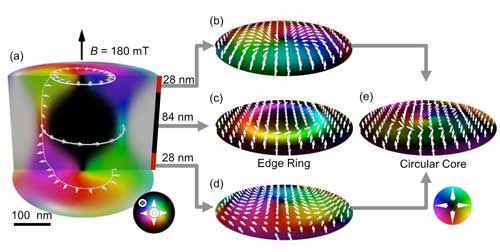| Nov 02, 2020 |
Scientists discover 3D skyrmion bubbles and novel magnetic configuration
(Nanowerk News) In a study recently published in ACS Nano ("Target Bubbles in Fe3Sn2 Nanodisks at Zero Magnetic Field"), a research group led by Prof. DU Haifeng and Dr. TANG Jin from the High Magnetic Field Laboratory of the Hefei Institutes of Physical Science reported a scientific breakthrough after they investigated magnetic textures in a Kagome crystal Fe3Sn2.
|
|
With the help of Lorentz transmission electron microscopy (Lorentz-TEM), the research group clarified, for the first time, the magnetic nature of multiple "topological textures" as three dimensional (3D) bubbles, and then further found a new type of vortex-like magnetic configurations, which was named as "Target Bubbles", at room temperature and zero magnetic field.
|
 |
| 3D skyrmion bubbles (Image: TANG Jin). (click on image to enlarge)
|
|
The type-I bubbles (renamed as skyrmion bubbles with the same topology as skyrmions) have remotivated general scientific interests. Scientists observed complex multi-ring and arc-shaped vortex-like configurations beyond the traditional magnetic bubbles. And similar complex magnetic configurations were also reported in other skyrmion bubble materials.
|
|
However, physical understanding of them, remains unclear, which prevents the further scientific exploration and application of skyrmion bubbles.
|
|
With the differential phase contrast (DPC) technique, the research group obtained more real features of these complex magnetic configurations. They found these complex multiple "topological textures" are actually 3D bubbles as simulated integral magnetizations of 3D magnetic bubbles is in highly consistence with the complex magnetic configurations obtained from DPC.
|
|
On this basis, they further fabricated Fe3Sn2 nanodisks and achieved a transition from a soft magnetic vortex to a new type of vortex-like configuration through a zero-field warming process. Such a new vortex-like configuration resembles a target and was named "Target Bubbles".
|
|
Target bubbles with rings tunable by nanodisk size had room-temperature stability even at zero magnetic field and multiple stable magnetic configurations. These advantages rendered the target bubble an ideal information bit of spintronic devices.
|
|
This research shed new light on the Skyrmions or skyrmion bubbles and paved the way for construction of high density and low energy consumption spintronic devices.
|

